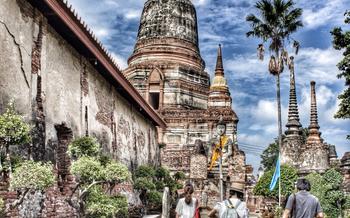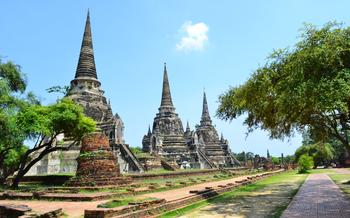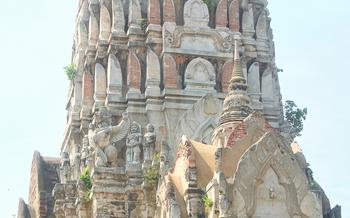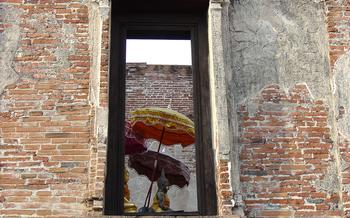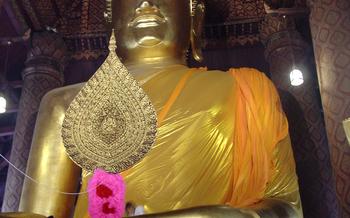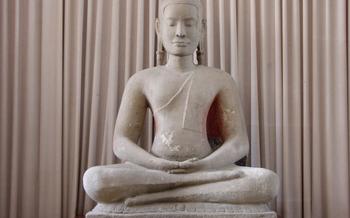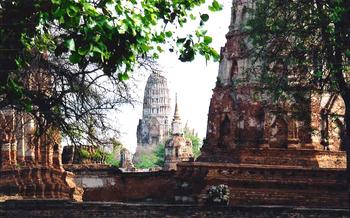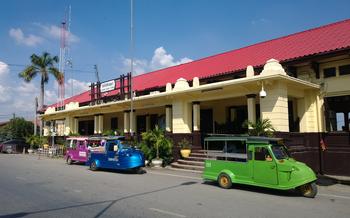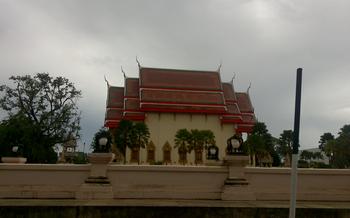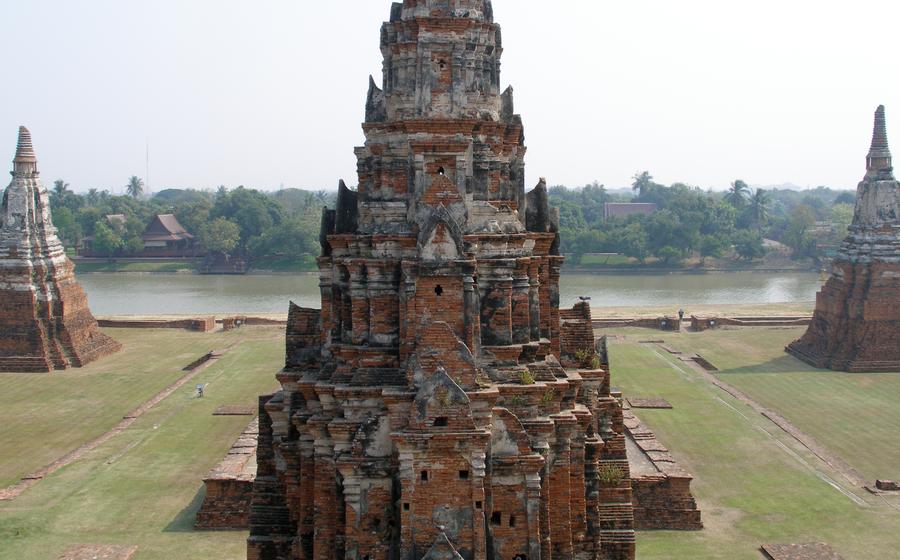
Wat Pradu Tabong
- Wat Pradu Tabong: A Stunning Historical Temple
- Exploring the Buddha Image at Wat Pradu Tabong
- Historical Background of Wat Pradu Tabong
- The Grounds and Surroundings
- Local Legends and Folklore
- Religious Significance and Ceremonies
- Visitor Facilities and Services
- Photography and Videography
- Conservation and Preservation Efforts
- Cultural Performances and Events
- Nearby Attractions and Points of Interest
- Other Temples and Historical Sites
- Museums and Markets
- Creating a Comprehensive Itinerary
- Transportation Options
- Ayutthaya Historical Park: A Journey Through History
- Accommodation and Dining Options
Wat Pradu Tabong: A Stunning Historical Temple
Wat Pradu Tabong is a captivating historical temple located in Ayutthaya, Thailand. It holds immense religious significance and is a testament to the grandeur of Ayutthaya's past. Built in the 16th century, the temple is adorned with intricate artwork, reflecting the architectural prowess of the era. The highlight of Wat Pradu Tabong is its giant reclining Buddha, which exudes serenity and invites contemplation. Visitors can immerse themselves in the temple's rich history, participate in religious ceremonies, and experience the tranquility of this sacred space. Remember to dress respectfully and observe proper temple etiquette to ensure a meaningful visit.
Exploring the Buddha Image at Wat Pradu Tabong
The centerpiece of Wat Pradu Tabong is its awe-inspiring reclining Buddha statue, a colossal representation of the Buddha in a state of serene repose. This gigantic Buddha image, known as Phra Buddha Saiyat, stretches an astounding 42 meters in length and stands 16 meters tall, making it one of the largest reclining Buddha statues in Thailand.
The sheer size and grandeur of the Buddha statue are truly breathtaking, commanding attention and instilling a sense of tranquility and reverence. The intricate details and delicate features of the Buddha's face, hands, and feet are a testament to the craftsmanship and devotion of the artisans who created this masterpiece.
The reclining posture of the Buddha symbolizes the transition from the earthly realm to the spiritual realm, representing the Buddha's entry into Parinirvana, the final stage of enlightenment and the cessation of worldly suffering. Devotees often pay homage to the Buddha statue by offering flowers, incense, and candles, seeking blessings and expressing gratitude.
Rituals and offerings play a significant role in the veneration of the Buddha image at Wat Pradu Tabong. Devotees engage in merit-making activities, such as making offerings of food, clothing, and other necessities to the monks residing at the temple. These acts of generosity are believed to bring good fortune and blessings.
Historical Background of Wat Pradu Tabong
In the 14th century, King Ramesuan, a revered monarch of the Ayutthaya Kingdom, embarked on a significant undertaking that would leave an enduring mark on history. He commanded the construction of Wat Pradu Tabong, a majestic temple that was to serve as a symbol of his devotion to Buddhism and as a testament to his reign. The temple's origins are intertwined with the king's personal life, as he sought solace and spiritual fulfillment amidst the trials and tribulations of ruling a vast kingdom.
Wat Pradu Tabong's founding was not merely a religious act; it was also a strategic move by King Ramesuan to consolidate his power and authority. By establishing a grand temple in the heart of his kingdom, he aimed to reinforce his legitimacy and inspire loyalty among his subjects. The temple's construction became a symbol of his commitment to fostering peace and prosperity throughout the realm.
Over the centuries, Wat Pradu Tabong witnessed numerous historical events that shaped the course of Ayutthaya's destiny. It served as a sanctuary for kings and queens, a place of worship for devout Buddhists, and a center for religious ceremonies and festivals. The temple's resilience and enduring significance are a testament to the deep-rooted cultural and spiritual heritage of the Thai people.
Despite the passage of time and the inevitable changes that accompanied it, Wat Pradu Tabong's essence remains unchanged. It continues to be a place of profound reverence and spiritual connection, drawing countless visitors who seek solace, enlightenment, and a glimpse into the rich history of Thailand's Ayutthaya period.
The Grounds and Surroundings
The temple complex of Wat Pradu Tabong is a testament to the grandeur and artistry of Ayutthaya's religious architecture. The sprawling grounds encompass a serene and contemplative atmosphere, inviting visitors to explore the various structures and features that adorn the temple.
As you enter the temple, your eyes are drawn to the meticulously landscaped gardens that flank the pathways, creating a vibrant tapestry of colors and textures. The well-maintained lawns and meticulously trimmed hedges add to the sense of order and tranquility that permeates the complex.
Within the grounds, you'll discover a number of other structures that contribute to the temple's rich architectural heritage. These include several smaller stupas and chedis, each with its own unique design and symbolism. The temple also features a number of pavilions and salas, which serve as places for meditation, prayer, and relaxation.
One of the most striking features of the temple grounds is the large pond that occupies a central position. The pond is home to a variety of aquatic plants and animals, and its tranquil waters create a sense of peace and serenity. Visitors can stroll along the pond's edge, enjoying the views and the gentle breeze that rustles through the trees.
The overall ambiance of Wat Pradu Tabong's grounds is one of tranquility and reverence. The harmonious blend of nature and architecture creates a sacred space that invites visitors to slow down, reflect, and connect with their spiritual side.
Local Legends and Folklore
Wat Pradu Tabong is steeped in myths, legends, and folklore that add to its mystique and cultural significance. One of the most well-known legends is the story of the reclining Buddha statue's origin. According to local lore, a wealthy merchant named Phra Ruang was sailing along the Chao Phraya River when his boat encountered a violent storm. He prayed to Buddha for protection, promising to build a temple if his life was spared. Miraculously, the storm ceased, and Phra Ruang kept his vow by constructing Wat Pradu Tabong and enshrining the giant reclining Buddha statue as its centerpiece.
Another popular tale associated with the temple involves a magical white elephant. It is said that the elephant appeared to a group of villagers, leading them to a hidden treasure buried within the temple grounds. The villagers used the treasure to restore and beautify Wat Pradu Tabong, transforming it into the magnificent temple it is today.
These legends and stories have been passed down through generations, enriching the cultural heritage of Wat Pradu Tabong and making it a beloved site for both locals and visitors.
Religious Significance and Ceremonies
Wat Pradu Tabong holds immense religious significance as a sacred Buddhist temple. The reclining Buddha image is a focal point of worship and devotion for both locals and visitors. Throughout the year, the temple hosts various festivals, rituals, and ceremonies that attract pilgrims and devotees from far and wide.
One of the most important festivals celebrated at Wat Pradu Tabong is the Phra Buddha Chinarat Festival, held annually in November. During this festival, the temple grounds come alive with vibrant processions, colorful decorations, and traditional performances. Devotees gather to pay homage to the Buddha image, offer prayers, and participate in merit-making activities.
Another significant ceremony is the Songkran Festival, also known as the Thai New Year, which takes place in April. During Songkran, people visit the temple to bathe the Buddha image with fragrant water as a symbol of purification and renewal. This ceremony is believed to bring good luck and blessings for the coming year.
Visitors are welcome to participate in these ceremonies and rituals, but it is important to be respectful and observe proper temple etiquette. Devotees typically make offerings of flowers, candles, and incense to the Buddha image, and it is customary to dress modestly and remove shoes before entering the temple grounds.
By immersing yourself in the religious ceremonies and traditions at Wat Pradu Tabong, you can gain a deeper understanding of the spiritual significance of this sacred temple and experience the vibrant Buddhist culture of Thailand.
Visitor Facilities and Services
Wat Pradu Tabong caters to visitors with a range of facilities and services to enhance their experience.
-
Restrooms: Clean and well-maintained restrooms are available within the temple complex for the convenience of visitors.
-
Food Stalls: For those seeking a quick bite or refreshment, several food stalls are located outside the temple grounds, offering a variety of local snacks and beverages.
-
Souvenir Shops: Visitors can purchase souvenirs, such as Buddha statues, amulets, and postcards, from the souvenir shops near the temple entrance.
-
Accessibility: Wat Pradu Tabong is generally accessible for visitors with disabilities, with ramps and designated parking spaces available.
-
Guided Tours: While official guided tours are not typically offered, visitors can hire local guides from outside the temple who can provide insights into its history and significance.
-
Information Services: A small information booth near the entrance provides brochures and basic information about the temple, including its history and religious significance.
Photography and Videography
Respectful Conduct and Capturing the Beauty
When visiting Wat Pradu Tabong, it is essential to maintain respectful conduct and avoid disruptive behavior. Photography and videography are permitted within the temple grounds, but visitors must adhere to certain guidelines. Flash photography is prohibited, as it can damage the delicate artwork and statues. Tripods and selfie sticks are also not allowed, as they can obstruct the movement of other visitors.
To capture the beauty of the Buddha image and its surroundings, photographers and videographers should use natural light whenever possible. Artificial lighting can alter the colors and ambiance of the temple, resulting in distorted images. It is recommended to arrive early in the morning or late in the afternoon, when the light is softer and more flattering. Composition is also crucial. Experiment with different angles and perspectives to create unique and memorable shots.
Visitors are encouraged to explore the temple grounds beyond the main Buddha image. Smaller Buddha statues, intricate carvings, and beautiful murals adorn the temple walls and walkways. These details contribute to the overall grandeur of Wat Pradu Tabong and offer ample opportunities for creative photography.
By following these guidelines and practicing respectful conduct, visitors can capture the essence of Wat Pradu Tabong and share its beauty with others while preserving the sanctity of this sacred site.
Conservation and Preservation Efforts
Wat Pradu Tabong, with its historical and cultural significance, requires ongoing efforts to preserve its heritage for future generations. Conservation projects have been initiated to restore and maintain the temple's structures, including the giant reclining Buddha image. These projects involve meticulous restoration work, using traditional techniques and materials to ensure authenticity.
Visitors can contribute to the preservation efforts by adhering to responsible tourism practices. Respectful behavior within the temple grounds, such as avoiding touching or climbing on the Buddha statue, helps protect the integrity of the site. Refraining from littering and using designated waste disposal areas ensures the cleanliness and beauty of the surroundings.
By supporting local initiatives and organizations involved in conservation, visitors can directly contribute to the preservation of Wat Pradu Tabong. Donations, volunteering, and spreading awareness about the temple's heritage are valuable ways to support these efforts.
Preserving Wat Pradu Tabong's unique heritage ensures that future generations can continue to appreciate its historical and cultural significance. Responsible tourism and community involvement play a crucial role in safeguarding this remarkable temple for years to come.
Cultural Performances and Events
Wat Pradu Tabong, in addition to its religious and historical significance, offers a vibrant tapestry of cultural performances and events that provide visitors with an immersive experience of Thai traditions. These events showcase the rich artistic heritage of Ayutthaya and offer a glimpse into the local way of life.
Traditional dance performances, often held in the temple grounds, captivate audiences with their graceful movements, colorful costumes, and melodious music. These dances, deeply rooted in Thai culture, narrate ancient stories and legends, bringing the past to life. Visitors can witness the intricate choreography and expressive gestures that convey a range of emotions and narratives.
Music plays an integral role in these performances, with traditional instruments such as the khene, saw duang, and ching creating a harmonious blend of sounds. The rhythmic beats and melodies transport visitors to a realm of enchantment, where the past and present intertwine.
Cultural performances at Wat Pradu Tabong are not limited to dance and music. Visitors may also encounter shadow puppetry, a captivating art form that uses intricate leather puppets to cast mesmerizing shadows on a screen. These performances, accompanied by live narration, showcase traditional stories and folklore, captivating audiences of all ages.
Participation in these cultural performances is highly encouraged. Visitors can learn the basic steps of traditional dances, try their hand at playing musical instruments, or even join in the shadow puppetry workshops. These interactive experiences offer a unique opportunity to connect with the local culture and create lasting memories.
To make the most of these cultural events, it is advisable to check the temple's website or inquire at the tourist information center for the schedule and timings. These events are often held on special occasions, such as temple festivals or national holidays, and provide an excellent opportunity to delve deeper into the rich cultural heritage of Ayutthaya.
Nearby Attractions and Points of Interest
Wat Pradu Tabong is situated in the heart of Ayutthaya, a city renowned for its rich history and cultural heritage. A visit to the temple can be easily combined with other nearby attractions, creating a comprehensive and immersive experience.
Just a short walk away lies the Wat Mahathat, another significant temple in Ayutthaya. It is famous for its iconic Buddha head entwined by the roots of a bodhi tree, a symbol of the harmonious coexistence of nature and spirituality.
Other Temples and Historical Sites
Ayutthaya is home to numerous other temples and historical sites, each with its own unique charm and significance. The Wat Chaiwatthanaram is an impressive temple complex known for its elegant architecture and well-preserved murals. The Wat Phra Si Sanphet was once the royal temple of the Ayutthaya Kingdom, and its ruins still exude an air of grandeur.
Museums and Markets
For those interested in delving deeper into Ayutthaya's history and culture, several museums offer insightful exhibits. The Chao Sam Phraya National Museum houses a collection of artifacts and relics showcasing the kingdom's rich past. The Ayutthaya Floating Market provides a glimpse into the city's vibrant local life and offers a unique shopping experience.
Creating a Comprehensive Itinerary
To make the most of your time in Ayutthaya, plan a comprehensive itinerary that allows you to visit several attractions in one day. Consider starting with Wat Pradu Tabong in the morning, followed by Wat Mahathat and Wat Chaiwatthanaram. In the afternoon, explore the Chao Sam Phraya National Museum and indulge in some shopping at the Ayutthaya Floating Market.
Transportation Options
Getting around Ayutthaya is convenient and affordable. Tuk-tuks, the city's iconic three-wheeled taxis, are readily available and provide a fun and inexpensive way to travel. Alternatively, you can rent a bicycle to explore at your own pace and immerse yourself in the city's vibrant atmosphere.
Ayutthaya Historical Park: A Journey Through History
Ayutthaya Historical Park, a UNESCO World Heritage Site, stands as a testament to the grandeur and rich history of the ancient Thai capital. Located just a short distance from Wat Pradu Tabong, this sprawling park encompasses an array of magnificent temples, ruins, and monuments, offering visitors a glimpse into the glorious past of Ayutthaya.
As you step into the park, you'll be transported back in time, surrounded by the remnants of a once-thriving city. Explore the ruins of Wat Mahathat, where the iconic Buddha head entwined by tree roots has become a symbol of Ayutthaya's resilience. Marvel at the grandeur of Wat Phra Sri Sanphet, the former royal temple, with its towering chedis and intricate carvings.
Don't miss the opportunity to climb to the top of Phra Ram Ratchaniwet, a watchtower offering panoramic views of the park and the surrounding countryside. As you wander through the ancient streets, you'll encounter countless other temples, each with its unique architectural features and historical significance.
To fully appreciate the park's grandeur, consider hiring a bicycle or joining a guided tour. This will allow you to cover more ground and learn about the history and significance of each site. Remember to dress respectfully, as the park is still an active religious site.
Whether you're a history buff, an architecture enthusiast, or simply someone who appreciates the beauty of ancient ruins, Ayutthaya Historical Park is a must-visit destination. Get ready to immerse yourself in the rich cultural heritage of Thailand and uncover the secrets of its glorious past.
Accommodation and Dining Options
Ayutthaya offers a diverse range of accommodation options to suit different budgets and preferences. From luxurious hotels to budget-friendly guesthouses and homestays, visitors can find a place to stay that meets their needs. For a truly immersive experience, consider staying in a traditional Thai-style house or a riverside resort.
When it comes to dining, Ayutthaya is a culinary paradise, offering a delectable array of Thai dishes. From street food stalls to upscale restaurants, there are options to satisfy every palate. Be sure to try local specialties such as boat noodles, mango sticky rice, and the famous Ayutthaya shrimp cakes. For a unique dining experience, visit the floating market, where you can sample a variety of dishes while cruising along the river.
Here are some recommendations for authentic and affordable dining experiences in Ayutthaya:
-
Ayutthaya Night Market: Immerse yourself in the vibrant atmosphere of the night market, where you can find an array of street food vendors selling delicious Thai dishes at reasonable prices.
-
Khao San Road: Known for its lively backpacker scene, Khao San Road is lined with restaurants and bars offering a variety of cuisines, including traditional Thai dishes.
-
Wat Mahathat Market: Located near the famous Wat Mahathat temple, this market offers a variety of local dishes, including the popular roti sai mai, a sweet and crispy roti filled with custard.
-
Bang Pa-In Royal Palace: Enjoy a meal at one of the restaurants within the beautiful Bang Pa-In Royal Palace, where you can savor Thai cuisine while surrounded by stunning scenery.
